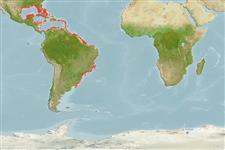Classification / Names
Common names from other countries
Main reference
Size / Weight / Age
Max length : 27.0 cm TL male/unsexed; (Ref. 103182); common length : 20.0 cm SL male/unsexed; (Ref. 188)
Length at first maturity
Lm 19.2 range ? - ? cm
Environment
Marine; brackish; pelagic-neritic; oceanodromous; depth range 5 - 60 m (Ref. 114041)
Climate / Range
Subtropical, preferred 26°C (Ref. 107945); 31°N - 36°S, 98°W - 35°W
Distribution
Western Atlantic: Gulf of Mexico, Caribbean, West Indies southward to Brazil and northern Uruguay (identifications are not always reliable).
Countries | FAO areas | Ecosystems | Occurrences | Introductions
Short description
Dorsal
spines
(total): 0;
Dorsal
soft rays
(total): 13-21;
Anal
spines: 0;
Anal
soft rays: 12 - 23. Diagnostic features as for Sardinella aurita from which it differs in having the anterior gill rakers on the lower limbs of the second and third gill arches distinctly curled downward (more or less flat in S. aurita) (Ref. 188). The pelvic fin ray count of i 8 distinguishes S. brasiliensis from all other species of Sardinella, also Harengula and Opisthonema (Ref. 188). Similar to S. aurita (Ref. 26938). Bluish black above. Peritoneum black (Ref. 37032). Separation of Sardinella brasiliensis (synonym of Sardinella janeiro) from Sardinella aurita on the basis of gill raker shape and a higher gill raker count is tentative.
IUCN Red List Status (Ref. 115185)
Threat to humans
Harmless
Human uses
Fisheries: highly commercial; bait: usually
More information
ReferencesAquacultureAquaculture profileStrainsGeneticsAllele frequenciesHeritabilityDiseasesProcessingMass conversion
Tools
Special reports
Download XML
Internet sources
Estimates of some properties based on models
Phylogenetic diversity index
PD50 = 0.5000 many relatives (e.g. carps) 0.5 - 2.0 few relatives (e.g. lungfishes)
Trophic Level
3.1 ±0.30 se; Based on food items.
Resilience
High, minimum population doubling time less than 15 months (K=0.44-0.72; tm=1)
Vulnerability
Low vulnerability (23 of 100)
Price category
